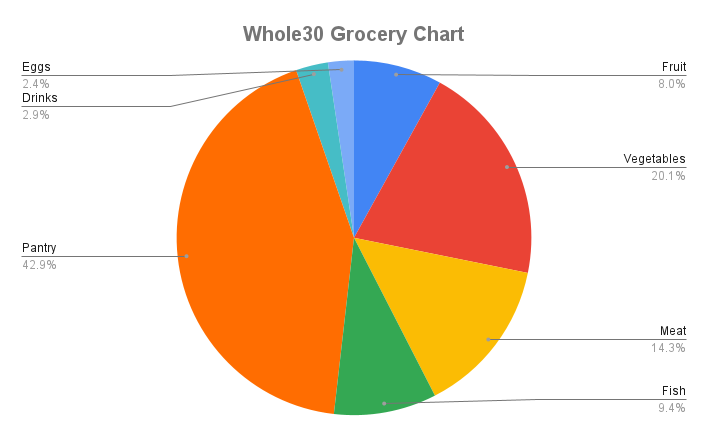Whole30 has a reputation for being an expensive diet.
As an elimination diet that focuses on clean eating (goodbye ingredients you can’t pronounce, all added sugars, grains, legumes, seed oils, and dairy), I’m here to confirm that it is expensive.
My husband and I decided to do Whole30 earlier this year to try to help my weird stomach.
In the process, my grocery bill nearly doubled.
Making the month of Whole30 some of the most expensive weeks of grocery bills we’ve ever seen.
Yes.
For me, the extra money was worth the food overhaul and the opportunity to be the most balanced I have been in terms of my stomach in a really long time.
Not to mention breaking my addiction to sugar (read honey, in my case).
It’s worth noting that Whole30 can definitely be done more economically.
More on that later.

Whole30 Cost
The short answer is, Whole30 almost doubled my grocery budget, costing me 82% more each week to feed my husband and I (and a few dinner guests) for the initial 30 day challenge + 2 weeks of reintroduction.
The 82% increase brought our weekly average grocery spending to: $204.28.
That’s $91.89 more than our average weekly spending of: $112.39.
(91.89 / 112.39 = 0.8175 x 100 = 81.8%)
The long answer is, the rest of this post will dive into the specifics to help give an idea of what it might cost you.
A Few Things to Note about the Numbers
$112.39 is based on our average spending at grocery stores the 13 months before Whole30.
This number is honestly a little higher than what we actually spend. I know this for a few reasons:
- We calculate our grocery spending in the store before we even get to the checkout counter to ensure we aren’t going over (just roundup as you go to account for taxes. I actually highly recommend this practice).
- While we calculate our food purchases in store prior to check out to make sure we’re in our desired spending range, we don’t include our nonfood items in this running total. We do, however, buy nonfood items from time to time. This means, the totals I pulled for grocery stores like Walmart, Rouses, Whole Foods, etc. didn’t include deductions for the times we buy things like toilet paper, paper towels, toothpaste, soap, or cosmetics, etc. While I made notes in my spreadsheet for some of the larger nonfood items and amounts that I can remember, I don’t usually keep receipts and get that granular with tracking in my spreadsheet. All that to say, some nonfood items were included in this weekly grocery average, but it’s close enough.
- This number also includes the times we have dinner guests over (which isn’t that often) but it is something to consider. I usually run to the store to pick up a few extra things when we have guests over, especially if we’re making something specific and out of our normal style of eating.
I mention this because in our first 2 years of marriage, we kept our grocery bill to around $60 – $65 a week.
As prices have increased and we have moved towards cleaner eating (so long chips and salsa for dinner 2 times a week), we have settled into a new normal of spending closer to $75 – $80 each week. This is a more accurate amount of spending for the two of us.
The numbers I’ll discuss in detail include 2 weeks of grocery bills during reintroduction. The phase of Whole30 where it’s recommended to reintroduce non-Whole30 approved items one by one.
Another important thing to note is we primarily eat deer meat as our source of protein, outside of buying chicken or fish. This fact is another story in terms of cost, but does keep our clean, free-range, grass / acorn fed, red meat purchases to $0 throughout the year, outside of hunting season.
Key Takeaways
My pre-Whole30 grocery spending ($112.38 per week) is inflated by about $20 – $38 in my estimation, but it’s close.
For the purposes of this post, that means the least Whole30 increased my weekly grocery bill was 82% and the most (based on $75 spending) was 172%. It more than doubled in the case of my regular spending.
As an additional gauge for you, before Whole30, my husband and I ate a 75/25 clean to not so clean style of eating.
Phew, I hope all that made sense.
What We Spent Exactly
I have included a breakdown of totals per store per week and a pie chart with an overview of where most of our money was spent as a percentage.
1st Week*
- Walmart – $111.15
- Whole Foods – $80.29
- Tota: $191.44
*This grocery run was made a couple of days before Whole30 kicked off so we could prep and try a few recipes.
2nd Week
- Rouses – $85.51
- Whole Foods – $39.73
- Walmart – $75.24
- Total: $200.48
3rd Week
- Walmart – $102.11
- Total: $102.11
4th Week
- Sprouts – $62.85
- Walmart – $93.78
- Rouses – $14.22
- Total: $170.85
5th Week
- Walmart – $104.62
- Rouses – $37.16
- Sprouts – $69.5
- Total: $211.28
6th Week*
- Rouses – $ 74.72
- Total – $74.72
*This week was the beginning of reintroducing dairy back in our diet. We also decided to start Keto, so we essentially cut out potatoes (the main carb on Whole30) and reintroduced dairy.
Week 7
- Walmart – $76.25
- Total – $76.25
Week 8
- Sprouts – $69.11
- Walmart – $21.62
- Total – $90.73
Grand Total
Through week 5 Totals :
- $876.16 total spent
- $175.23 average each week total
Through week 8 Totals:
- $1,117.86 total spent
- $139.73 average each week total
Money Spent Per Category
Here’s what we spent per category during Whole30.
This is not the breakout of all the receipts from 8 weeks, but it is the majority of spending during weeks 1 – 4.

The categories of our spending included:
- Fruit
- Vegetables
- Meat
- Fish
- Pantry
- Eggs
- Drinks
The drinks section is something that cost us $20 and was certainly not needed.
Sparkling water was not something we did prior to Whole30, but it was a nice refreshing mix up since we weren’t drinking alcohol or milk, and in my case, coffee.
Spending Analysis
Startup Cost
There were some obvious startup costs for the first two weeks of Whole30.
This cost included money spent and time.
As noted in the pie chart, the biggest area of spending was the ‘Pantry’ category.
This amount was high because we needed to stock up on baseline ingredients that would become our go-to items (like olive oil, coconut milk, and nuts) during the month of Whole30 cooking.
The initial process of label reading made shopping take way longer than you’d ever want it to take in the first couple of weeks of Whole30. We went to the grocery store during non rush hour times and just slowly made our way through the aisles buying things on our list and double checking that the ingredients were Whole30 approved.
This involved a lot of Googling, but once the time is put in, it’s done.
After you find the best stores and brands to buy compliant ingredients from, it gets easier to know what aisle to just skip and what stores were best for buying certain ingredients.
Dirty Whole30?
The term ‘dirty Whole30’ is slang used to describe completing the diet by eating whole foods for the month, but neglecting to only buy grass fed or organic items in terms of the meat and veggies consumed.
Dirty Whole30 is definitely a category we fell in, as we didn’t buy organic fruits and veggies and also chose to simply buy regular chicken and eggs instead of buying free range organic chicken or eggs.
This is important to note in our analysis because it certainly allowed us to save money in the process.
Keep in mind, the red meat we consumed, including ground meat, steaks, stew meats, etc., was all sourced from wild game deer meat.
As an aside to the cost variance of completing ‘dirty Whole30’, we still felt noticeably better in our bodies and stomachs than we did before Whole30.
The Simplicity of Whole30 Shopping
A few weeks into Whole30 and we found we didn’t need as many ‘Pantry’ items and only ended up spending $51.10 to restock our weekly staples in week 3.
Those staples consisted of fresh fruit and veggies, potatoes, and eggs.
Baked potatoes with ghee, lightly seasoned, with a fried egg on top quickly became our staple breakfast. Add a nice heap of ground meat to that same dish and you’ve got a quick dinner that is filling and tastes great as well.
Once you take the time to read all the labels the first few trips, it gets more simple during weekly shopping to know your way around the store. Honestly, it makes shopping easier because there are many aisles you learn to just skip.
The simplicity of Whole30 was something we started to appreciate near the end of the month after we had settled into the new style of eating.
What to Skip
The main thing I would have skipped was the wasabi powder we got for a recipe we never used. It was $10 dollars and we only tried a little bit of it, and it turned out pretty gross.
Also, while I think having sugar-free high quality bacon the first couple of weeks was a good idea to get us started and to boost the morale, it was not cheap and ended up not being necessary for us in the end.
The next thing I would have skipped, because I had never tried it, was signing up for a Thrive Market 30 day free trial membership. While I got a good deal on some high quality supplements, the other staples I bought, like almond butter, ended up being about the same as Whole Foods prices.
How to Do Better
I know for a fact I could have done better with our spending on Whole30 by learning how to make my own excellent tasting, high grade texture, dressings and condiments.
We initially stocked up on Primal Kitchen dressings and some condiments and while it was extremely helpful in the beginning, I never strayed away from making the homemade mayo and chimichurri sauce every week.
I know I could have applied the same time and effort to making dressings and even salsa or BBQ sauce and it would have likely saved us around $30 or so net money.
I think it was worth the time saved for me personally to buy more premade dressings, but it is a place that can be trimmed. Also keep in mind, my estimated savings includes the reality of having to buy more ingredients to make the dressings.
If I would have skipped dressings and condiments altogether, it would have been more of a $45-$50 savings as each Primal Kitchen item costs $5.38 at Walmart (and $6.44 at Sprouts and Whole Foods…for the same dressing).
Grocery Store Tips
On Whole30 you can expect to go to the grocery store a little more than normal.
In the weeks leading up to starting Whole30, we shopped at a couple of different stores to stock up on compliant items like condiments, bacon, nut butters, etc.
After the first couple of weeks, I quickly understood what deals were best at what stores.
For the most part, grocery stores are created equal in terms of what items and brands they carry.
Unless we’re talking about Trader Joes.
That store is in a category all its own and very different compared to other stores. So much so that I never know what to buy when I go because I don’t recognize any of the brands.
If I had to rank the stores I shopped at in a ‘most likely to’ list, it’d go something like this.
- Whole Foods – most likely to make you go broke (aside from the organic almond butter – a good buy)
- Sprouts – most likely to give you the best deal on berries and bulk nuts
- Rouses – most likely to fulfill your basic Whole30 needs, just don’t ask too much
- Walmart – most likely to frustrate you, but also to deliver the best deals on Primal Kitchen items and to actually carry boneless skinless chicken thighs
Whole Foods and Sprouts are in a slightly different category compared to Walmart and Rouses, as they tend to have more selections of Whole30 compliant items, but that comes at an overall higher price.
At the end of the day, the brands are not so much what you’re after while on Whole30. It’s more about the selection of clean whole foods that are not prepackaged or premade.
Since we’re ultimately here to talk about money, here’s a few granular notes I took regarding prices and where I could have saved during Whole30.
- Walmart was a great place to get compliant Primal Kitchen salad dressings and condiments for the best price. $5.44 isn’t cheap for an 8 oz bottle of dressing, but it’s cheaper than the $6.44 it was at Whole Foods or $5.99 at Sprouts for the SAME dressing.
- Whole Foods and Sprouts were the only places we could find bacon without sugar in it. Sprouts came out a few cents cheaper when it came to compliant bacon.
- Whole Foods’ 365 almond butter is still the best price per unit almond butter I have found, even though the price increased by around 50 cents in the last year or so.
- Thrive Market has a comparable price per unit ounce of almond butter, but the consistency of their Thrive Market brand almond butter is really thin and soupy.
- Sprouts is the place to go for cheaper cashews at $3.99 lb. Although, they are treated with canola oil, which technically is Whole30 compliant, but it is recommended to limit canola oil consumption.
- Sprouts also has the best spots for sales on berries. I can pick up a pint or four of blueberries for $3-$4 if I catch the deal. Raspberries are sold for similar prices.
Style of Eating before Whole30
Taking note of your style of eating before Whole30 is a good way to gauge how much of a price increase in groceries you’ll be facing.
I’d describe our style of eating prior to Whole30 as falling in the 75/25 category of eating.
75% of what we bought was clean (fresh produce, vegetables, fruit, high quality bread, some dairy, etc.) and 25% was not so clean (chips, processed meats like sandwich meat and frozen pre-made chicken patties, low-grade salad dressings, hummus and pita chips filled with soybean oil, etc.).
Dairy is a controversial one as far as it being considered clean, but that’s another topic for another day.
The more clean you eat now, the less of a shock your budget will receive.
On the other hand, if you currently eat at fast food restaurants and buy a smaller amount of clean grocery items, you can expect your grocery budget to increase a little more.
Your style of eating is a good thing to consider as you prepare to calibrate to a new way of eating and try to project how much the month will end up costing.
The way I determined my clean to not so clean ratios was to take a look at some old receipts (if I could find them) and assess the items on the list.
If it was something processed and not from the veggie, meat, or dairy section of the store, it got put in the not so clean category. The percentage was simply based on the average totals of each category.
Nothing too specific, but it gave me a good idea of how we actually rank.
Reintroduction
The reintroduction phase for us was a little tricky. We decided to roll right into Keto.
The bills following the close of our actual Whole30 month included several trips that came to an average total of $76.
The main thing we switched up was replacing potatoes with dairy. Instead of buying a few sacks of potatoes a week, we instead bought cheeses, milks, butter and eventually yogurt.
At this stage, our bills had started to settle back into our routine spending. This was due to hitting a stride with what types of meals we cooked on Whole30, as well as having dairy back on the list.
How Does this Help You?
Knowing how much Whole30 costs someone else is a good start, but how does this help you?
To get an idea of the cost for your lifestyle, take a minute to consider a few things:
- What is your style of eating* now?
- What do you spend on groceries now? (approximately)
- What grocery stores are near you and would be best for buying fresh items for a deal?
- Set aside time to pre-plan and do the legwork of getting set up for the weeks of Whole30
*Style of eating here means how clean you eat.
This is important because clean eating is relative to the cost of groceries because buying less clean food ends up being less expensive.
In a sense, converting the 25% of not so clean foods to clean foods in our case is what cost us the extra. Losing the calories you’d usually spend eating things like dairy, chips, breads / grains, etc., all have to be replaced with clean meats and veggies for the month.
Buying fresh food is just more expensive than pre-packaged food.
Take a few grocery runs to spend some extra time reading labels or paying attention to the deals run on fresh produce and berries, if any. This knowledge will be helpful during your Whole30 month.
Assess some recipes and items that will be your go-to meals during your Whole30 month. If you don’t eat bacon now, maybe don’t splurge and get the sugar-free bacon during Whole30. If you don’t drink sparkling water now, don’t start picking it up during Whole30.
It is important to set aside time to read labels, learn new recipes, and cook. Factor in the time it will take to adjust, and just embrace it for the few weeks of Whole30. It will be worthwhile in the end.





[…] discussed how expensive the Whole30 diet can […]